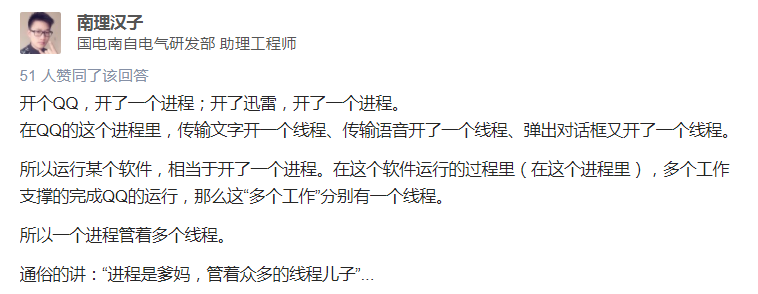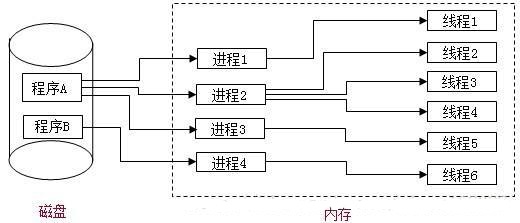- ubuntu12.04环境下使用kvm ioctl接口实现最简单的虚拟机
- Ubuntu 通过无线网络安装Ubuntu Server启动系统后连接无线网络的方法
- 在Ubuntu上搭建网桥的方法
- ubuntu 虚拟机上网方式及相关配置详解
CFSDN坚持开源创造价值,我们致力于搭建一个资源共享平台,让每一个IT人在这里找到属于你的精彩世界.
这篇CFSDN的博客文章java多线程之线程,进程和Synchronized概念初解由作者收集整理,如果你对这篇文章有兴趣,记得点赞哟.
1、进程与线程的概念 。
(1)在传统的操作系统中,程序并不能独立运行,作为资源分配和独立运行的基本单位都是进程.
在未配置 os 的系统中,程序的执行方式是顺序执行,即必须在一个程序执行完后,才允许另一个程序执行;在多道程序环境下,则允许多个程序并发执行。程序的这两种执行方式间有着显著的不同。也正是程序并发执行时的这种特征,才导致了在操作系统中引入进程的概念.
自从在 20 世纪 60 年代人们提出了进程的概念后,在 os 中一直都是以进程作为能拥有资源和独立运行的基本单位的。直到 20 世纪 80 年代中期,人们又提出了比进程更小的能独立运行的基本单位——线程(threads),试图用它来提高系统内程序并发执行的程度,从而可进一步提高系统的吞吐量。特别是在进入 20 世纪 90 年代后,多处理机系统得到迅速发展,线程能比进程更好地提高程序的并行执行程度,充分地发挥多处理机的优越性,因而在近几年所推出的多处理机 os 中也都引入了线程,以改善 os 的性能.
—–以上摘自《计算机操作系统-汤小丹等编著-3 版》 。
(2)下图是来自知乎用户的解释:

通过上述的大致了解,基本知道线程和进程是干什么的了,那么我们下边给进程和线程总结一下概念:
(3)进程(process)是计算机中的程序关于某数据集合上的一次运行活动,是系统进行资源分配和调度的基本单位,是操作系统结构的基础。在早期面向进程设计的计算机结构中,进程是程序的基本执行实体;在当代面向线程设计的计算机结构中,进程是线程的容器。程序是指令、数据及其组织形式的描述,进程是程序的实体.
(4)线程,有时被称为轻量级进程(lightweight process,lwp),是程序执行流的最小单元。线程是程序中一个单一的顺序控制流程。进程内一个相对独立的、可调度的执行单元,是系统独立调度和分派cpu的基本单位指运行中的程序的调度单位。在单个程序中同时运行多个线程完成不同的工作,称为多线程.
(5)进程和线程的关系:

2、java实现多线程方式 。
(1)继承thread,重写run()方法 。
|
1
2
3
4
5
6
7
8
9
10
11
12
13
14
|
public
class
mythread
extends
thread {
@override
public
void
run() {
while
(
true
) {
system.out.println(
this
.currentthread().getname());
}
}
public
static
void
main(string[] args) {
mythread thread =
new
mythread();
thread.start();
//线程启动的正确方式
}
}
|
输出结果:
|
1
2
3
4
|
thread-
0
thread-
0
thread-
0
...
|
另外,要明白启动线程的是start()方法而不是run()方法,如果用run()方法,那么他就是一个普通的方法执行了.
(2)实现runable接口 。
|
1
2
3
4
5
6
7
8
9
10
11
12
13
|
public
class
myrunnable
implements
runnable {
@override
public
void
run() {
system.out.println(
"123"
);
}
public
static
void
main(string[] args) {
myrunnable myrunnable =
new
myrunnable();
thread thread =
new
thread(myrunnable,
"t1"
);
thread.start();
}
}
|
3、线程安全 。
线程安全概念:当多个线程访问某一个类(对象或方法)时,这个类始终能表现出正确的行为,那么这个类(对象或方法)就是线程安全的.
线程安全就是多线程访问时,采用了加锁机制,当一个线程访问该类的某个数据时,进行保护,其他线程不能进行访问直到该线程读取完,其他线程才可使用。不会出现数据不一致或者数据污染。 线程不安全就是不提供数据访问保护,有可能出现多个线程先后更改数据造成所得到的数据是脏数据。这里的加锁机制常见的如:synchronized 。
4、synchronized修饰符 。
(1)synchronized:可以在任意对象及方法上加锁,而加锁的这段代码称为“互斥区”或“临界区”.
(2)**不使用**synchronized实例(代码a):
|
1
2
3
4
5
6
7
8
9
10
11
12
13
14
15
16
17
18
19
20
21
|
public
class
mythread
extends
thread {
private
int
count =
5
;
@override
public
void
run() {
count--;
system.out.println(
this
.currentthread().getname() +
" count:"
+ count);
}
public
static
void
main(string[] args) {
mythread mythread =
new
mythread();
thread thread1 =
new
thread(mythread,
"thread1"
);
thread thread2 =
new
thread(mythread,
"thread2"
);
thread thread3 =
new
thread(mythread,
"thread3"
);
thread thread4 =
new
thread(mythread,
"thread4"
);
thread thread5 =
new
thread(mythread,
"thread5"
);
thread1.start();
thread2.start();
thread3.start();
thread4.start();
thread5.start();
}
}
|
输出的一种结果如下:
|
1
2
3
4
5
|
thread3 count:
2
thread4 count:
1
thread1 count:
2
thread2 count:
3
thread5 count:
0
|
可以看到,上述的结果是不正确的,这是因为,多个线程同时操作run()方法,对count进行修改,进而造成错误.
(3)**使用**synchronized实例(代码b):
|
1
2
3
4
5
6
7
8
9
10
11
12
13
14
15
16
17
18
19
20
21
22
23
24
|
public
class
mythread
extends
thread {
private
int
count =
5
;
@override
public
synchronized
void
run() {
count--;
system.out.println(
this
.currentthread().getname() +
" count:"
+ count);
}
public
static
void
main(string[] args) {
mythread mythread =
new
mythread();
thread thread1 =
new
thread(mythread,
"thread1"
);
thread thread2 =
new
thread(mythread,
"thread2"
);
thread thread3 =
new
thread(mythread,
"thread3"
);
thread thread4 =
new
thread(mythread,
"thread4"
);
thread thread5 =
new
thread(mythread,
"thread5"
);
thread1.start();
thread2.start();
thread3.start();
thread4.start();
thread5.start();
}
}
|
输出结果:
|
1
2
3
4
5
|
thread1 count:
4
thread2 count:
3
thread3 count:
2
thread5 count:
1
thread4 count:
0
|
可以看出代码a和代码b的区别就是在run()方法上加上了synchronized修饰.
说明如下:
当多个线程访问mythread 的run方法的时候,如果使用了synchronized修饰,那个多线程就会以排队的方式进行处理(这里排队是按照cpu分配的先后顺序而定的),一个线程想要执行synchronized修饰的方法里的代码,首先是尝试获得锁,如果拿到锁,执行synchronized代码体的内容,如果拿不到锁的话,这个线程就会不断的尝试获得这把锁,直到拿到为止,而且多个线程同时去竞争这把锁,也就是会出现锁竞争的问题.
5、一个对象有一把锁!多个线程多个锁! 。
何为,一个对象一把锁,多个线程多个锁!首先看一下下边的实例代码(代码c):
|
1
2
3
4
5
6
7
8
9
10
11
12
13
14
15
16
17
18
19
20
21
22
23
24
25
26
27
28
29
30
31
32
33
34
35
|
public
class
multithread {
private
int
num =
200
;
public
synchronized
void
printnum(string threadname, string tag) {
if
(tag.equals(
"a"
)) {
num = num -
100
;
system.out.println(threadname +
" tag a,set num over!"
);
}
else
{
num = num -
200
;
system.out.println(threadname +
" tag b,set num over!"
);
}
system.out.println(threadname +
" tag "
+ tag +
", num = "
+ num);
}
public
static
void
main(string[] args)
throws
interruptedexception {
final
multithread multithread1 =
new
multithread();
final
multithread multithread2 =
new
multithread();
new
thread(
new
runnable() {
public
void
run() {
multithread1.printnum(
"thread1"
,
"a"
);
}
}).start();
thread.sleep(
5000
);
system.out.println(
"等待5秒,确保thread1已经执行完毕!"
);
new
thread(
new
runnable() {
public
void
run() {
multithread2.printnum(
"thread2"
,
"b"
);
}
}).start();
}
}
|
输出结果:
|
1
2
3
4
5
|
thread1 tag a,set num over!
thread1 tag a, num =
100
等待
5
秒,确保thread1已经执行完毕!
thread2 tag b,set num over!
thread2 tag b, num =
0
|
可以看出,有两个对象:multithread1和multithread2,如果多个对象使用同一把锁的话,那么上述执行的结果就应该是:thread2 tag b, num = -100,因此,是每一个对象拥有该对象的锁的.
关键字synchronized取得的锁都是对象锁,而不是把一段代码或方法当做锁,所以上述实例代码c中哪个线程先执行synchronized 关键字的方法,那个线程就持有该方法所属对象的锁,两个对象,线程获得的就是两个不同对象的不同的锁,他们互补影响的.
那么,我们在正常的场景的时候,肯定是有一种情况的就是,所有的对象会对一个变量count进行操作,那么如何实现哪?很简单就是加static,我们知道,用static修改的方法或者变量,在该类的所有对象是具有相同的引用的,这样的话,无论实例化多少对象,调用的都是一个方法,代码如下(代码d):
|
1
2
3
4
5
6
7
8
9
10
11
12
13
14
15
16
17
18
19
20
21
22
23
24
25
26
27
28
29
30
31
32
33
34
35
|
public
class
multithread {
private
static
int
num =
200
;
public
static
synchronized
void
printnum(string threadname, string tag) {
if
(tag.equals(
"a"
)) {
num = num -
100
;
system.out.println(threadname +
" tag a,set num over!"
);
}
else
{
num = num -
200
;
system.out.println(threadname +
" tag b,set num over!"
);
}
system.out.println(threadname +
" tag "
+ tag +
", num = "
+ num);
}
public
static
void
main(string[] args)
throws
interruptedexception {
final
multithread multithread1 =
new
multithread();
final
multithread multithread2 =
new
multithread();
new
thread(
new
runnable() {
public
void
run() {
multithread1.printnum(
"thread1"
,
"a"
);
}
}).start();
thread.sleep(
5000
);
system.out.println(
"等待5秒,确保thread1已经执行完毕!"
);
new
thread(
new
runnable() {
public
void
run() {
multithread2.printnum(
"thread2"
,
"b"
);
}
}).start();
}
}
|
输出结果:
|
1
2
3
4
5
|
thread1 tag a,set num over!
thread1 tag a, num =
100
等待
5
秒,确保thread1已经执行完毕!
thread2 tag b,set num over!
thread2 tag b, num = -
100
|
可以看出,对变量和方法都加上了static修饰,就可以实现我们所需要的场景,同时也说明了,对于非静态static修饰的方法或变量,是一个对象一把锁的.
6、对象锁的同步和异步 。
(1)同步:synchronized 。
同步的概念就是共享,我们要知道“共享”这两个字,如果不是共享的资源,就没有必要进行同步,也就是没有必要进行加锁; 。
同步的目的就是为了线程的安全,其实对于线程的安全,需要满足两个最基本的特性:原子性和可见性,
(2)异步:asynchronized 。
异步的概念就是独立,相互之间不受到任何制约,两者之间没有任何关系.
(3)示例代码:
|
1
2
3
4
5
6
7
8
9
10
11
12
13
14
15
16
17
18
19
20
21
22
23
24
25
|
public
class
myobject {
public
void
method() {
system.out.println(thread.currentthread().getname());
}
public
static
void
main(string[] args) {
final
myobject myobject =
new
myobject();
thread t1 =
new
thread(
new
runnable() {
public
void
run() {
myobject.method();
}
},
"t1"
);
thread t2 =
new
thread(
new
runnable() {
public
void
run() {
myobject.method();
}
},
"t2"
);
t1.start();
t2.start();
}
}
|
上述代码中method()就是异步的方法.
总结 。
以上就是本文关于java多线程之线程,进程和synchronized概念初解的全部内容,希望对大家有所帮助。如有不足之处,欢迎留言指出,小编会及时回复大家的.
原文链接:http://blog.csdn.net/xlgen157387/article/details/77920497 。
最后此篇关于java多线程之线程,进程和Synchronized概念初解的文章就讲到这里了,如果你想了解更多关于java多线程之线程,进程和Synchronized概念初解的内容请搜索CFSDN的文章或继续浏览相关文章,希望大家以后支持我的博客! 。
我希望通过扫描线为 x 的每个值找到 y 的值来绘制椭圆。 对于普通椭圆,公式很容易找到:y = Sqrt[b^2 - (b^2 x^2)/a^2] 但是当椭圆的轴旋转时,我一直无法弄清楚如何计算 y
假设我有这个矩阵: 1 1 1 | 1 0 0 1 | 1 这个系统显然有无限的解决方案。 x1 = -x2 x3 = 1 x1 依赖于 x2,x2 是免费的,但我感兴趣的是 x3。是否有一种算法可以
我正在考虑使用神经网络在我正在构建的太空射击游戏中为我的敌人提供动力,我想知道;当网络没有一个明确的好的输出集时,你如何训练神经网络? 最佳答案 我目前正在研究神经网络,如果没有明确定义的输入和输出编
我需要一个针对受限资源环境(例如具有以下特征的二进制(十六进制数据)嵌入式系统)进行优化的快速解压缩例程: 数据面向 8 位(字节)(数据总线为 8 位宽)。 字节值的范围并不统一为 0 - 0xFF
PHP代码: $txt="John has cat and dog."; //plain text $txt=base64_encode($txt); //base64 encode $txt=gzd
程序从用户那里接收到一个正数k,并且应该检查方程有多少解 3*x+5*y=k 在许多解决方案的情况下,该函数采用所有解决方案中 |x-y| 的较大绝对值。如果只有一种解决方案,它会打印出来。例如: 如
我必须求解以下微分方程: 或 如果没有 F_1 术语,代码就很简单。但我无法用包含 F_1 项来解决它,尽管我知道解决方案应该看起来像阻尼谐振。 from scipy.integrate import
我知道这个问题是前缀和的变体,我只是在设置它时遇到了一些困难。 最佳答案 定义: P[i] = A[i+1] + A[i+2] + ... + A[n] Q[i] = A[1] + ... + A[i
在许多在线示例中,文件在 Java 中使用编码缓冲区进行(解)压缩。然而,对于 NIO,无需选择一个好的缓冲区大小。我找到了文件和套接字的示例,但是是否有用于压缩输入的 NIO channel (例如
我有一个形式为 A*x = B 的方程组,其中 [A] 是一个三对角系数矩阵。使用 Numpy 求解器 numpy.linalg.solve 我可以求解 x 的方程组。 请参阅下面的示例,了解我如何开
我试图回答这个问题,只使用递归(动态编程) http://en.wikipedia.org/wiki/Longest_increasing_subsequence 从这篇文章中,我意识到最有效的现有解
解决此问题的方法是,按照我发帖的其中一项建议,将DLL添加到GAC中。正如我在我的一份答复中所指出的那样,在需要运行此过程的环境中,可伸缩性将不可用。因此,不能选择简单的解决方案。为了解决这个问题,我
是否有专门描述 AAC-LC 标准的规范,以及实现编解码器的现实目标,而不是通用编解码器,而是针对特定 AAC-LC 格式,具有预定义的 channel 数和采样率? 是否有一些针对 AAC-LC 的
我想使用通用的“p”来定义多路复用器将有多少输出。输入和所有输出均为 1 位。输出、控制和输入可以很简单,例如: signal control : std_logic_vector(log 2 p
我正在尝试在 javascript 中使用一些三 Angular 函数来定位一些菱形 div,但似乎我的逻辑在某处失败了。 你可以看到我尝试了这个公式:pos + trig * dimension。我
关闭。这个问题需要更多focused .它目前不接受答案。 想改进这个问题吗? 更新问题,使其只关注一个问题 editing this post . 关闭 4 年前。 Improve this qu
我一直在考虑这两个 JSON 库: 谷歌 Gson JSON.Simple XStream Google Gson 非常棒,它可以序列化具有无参数构造函数的类对象。 JSON.Simple 非常简洁,
使用 Gekko 拟合数据的数值 ODE 解。 嗨,大家好! 我想知道是否可以使用 GEKKO 拟合 ODE 的系数。 我尝试复制 example given here 失败. 这是我想出的(但有缺陷
众所周知,ASCII使用7位来编码字符,所以用来表示文本的字节数总是小于文本字母的长度 例如: StringBuilder text = new StringBuilder(); In
我找到了一个 link其中显示了一个示例,当线性方程组有无限多个解时,Matlab mldivide 运算符 (\) 给出“特殊”解。 例如: A = [1 2 0; 0 4 3]; b = [8;

我是一名优秀的程序员,十分优秀!